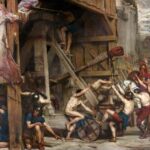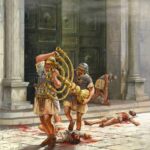Chapters
Jewish uprising of 66-73/74 CE is one of the most interesting and long-lasting conflicts of the first century CE. We can closely follow the history of the rebellion thanks to an excellent source that has survived our times – Josephus’ Jewish War. The military intervention of the Syrian legate Cestius Gallus against the rebels, described in the pages of this work, was to nip the resistance of the insurgents in the bud and restore peace in Judea. However, this expedition ended, contrary to expectations, with a painful defeat for the Romans and a strengthening of the position of the insurgents.
Historical background
The desecration by the Greek population of the synagogue in Caesarea on the seaside, the attempt to confiscate 17 talents from the temple treasury in Jerusalem by the Roman procurator Gesius Florus, and the desire to crack down on demonstrators protesting against this tax became the hotspots that led to the outbreak of the Jewish uprising in CE 66. The prosecutor of Judea Florus, not wanting to prove to be incompetent in the eyes of his superiors, tried himself to deal with the riots that broke out in Jerusalem. However, not having sufficiently large forces (as a governor in the rank of equice, he had only auxiliary troops at his disposal – auxilia), he was unable to oppose the rebels, who consequently took control of Jerusalem and a large area of the province. Gesius Florus, realizing the gravity of the situation, informed the legate of Syria, Cestius Gallus, to whom he was directly subordinate, about the revolt that had been raised in Judea.
The Forces of Cestius Gallus
We do not know when news of the rebels taking control of Jerusalem reached Cestius Gallus; it is certain, however, that shortly after receiving this information, the legate began a hasty mobilization of his troops. The main force in the Gallus army was the XII Flumianata legion and troops spun off from three other legions (vexillationes), possibly the leg. III Gallica, leg. VI Ferrata and leg. X Fretensis, each of these units was to consist of about 2,000 soldiers. The army that was to intervene in Judea in 66 CE it also included branches of the local rulers: Agrippa II, Antiochus IV and Sojamos. It is estimated that the army of Gallus could count from 25,000 to 30,000 soldiers. The place of concentration of troops was Antioch.
The course of the expedition
Gallus probably realized that the quickest way to suppress a rebellion would be to seize Jerusalem, but to protect himself from a possible attack on the rear of his army and from disrupting communication and supply routes, he decided that his first goal would be to restore order in Galilee and Samaria. In early September 66 CE the legate traveled with the army to Ptolemais on the border of Galilee. Then, heading south, he came to Caesarea by the seaside. Here, the army was divided into smaller units, and individual units began to pacify the vicinity of the city. One of them and the fleet were sent to take over Joppa – the port used by the Jewish corsairs. Thanks to the simultaneous attack from sea and land, Joppa was quickly captured, then looted and burned. After pacifying the area of Caesarea, the Romans marched on Sephforis, which capitulated without a fight. Gallus’ next target was Mount Azmon, around which the forces of Galilean insurgents gathered. Confident rebels took a convenient position on the mountainside and launched a battle against the legate’s forces. The Romans, using their advantage in training and armament, defeated the enemy, calming the last such large-scale revolt in Galilee.
After securing the rear, Gallus decided to march to Jerusalem. The fastest way from Caesarea to the Holy City was through the Beth Horon Pass. Marching towards the pass, the Romans seized Antpatryda, Afek and Lydda, which was plundered and burned. About 3 days after their departure towards Jerusalem, Cestius’ army entered the Beth Horon Pass. Roman forces covered a large part of the way without encountering any resistance from the insurgents and then camped overnight in Gabao, about 9 kilometres from Jerusalem. The next day, the march on the city resumed, but Gallus decided to change the formation of the marching column. He moved the trains to the very end of the marching army, probably to increase the speed of the march. The insurgents, not wanting to let Gallus’ troops approach the walls of Jerusalem, hid on both sides of the road leading from Gabao to the city. They let the advance guard through and attacked the main forces of the legate. Initially surprised, the Romans began to succumb to the pressure of the rebels, but the successful attack of the Romans’ front and rear guards prevented the defeat of the expedition. The rebels, preferring not to risk further losses, withdrew to the city. Also, the Roman forces, tired of fighting, withdrew to the camp in Gabao. As a result of the skirmish, 515 Gallus soldiers and 22 insurgents were to die. Also, some of the Roman camps with supplies and siege equipment were taken over by the Jews.
After an unsuccessful attempt to reach Jerusalem, Cestius suspended all activities for 3 days, hoping that the city would be captured as a result of negotiations with the rebels. However, when the negotiations failed, the Romans set off for Jerusalem a second time. This time they managed to reach the city itself. A camp was set up on Mount Skopos, from which the soldiers set out for the next few days to plunder the vicinity of the city in order to get food. After three days, the Romans attacked and burned the most poorly defended part of the city – Bezeta, whose walls have not yet been completed. Despite this success, subsequent assaults on the fortified rebel positions did not bring the desired results.
Shortages in supplies and the difficulties related to the possible conduct of the siege in the fall and winter forced Cestius to decide to withdraw from Jerusalem. The legate’s troops were to return to Caesarea. Confident insurgents set off in pursuit of the retreating Gallus. Despite the numerous losses that the rebels inflicted on the Romans, the legate’s forces managed to reach the camp in Gabao, where the army spent the next two days. The Romans returned by the same route they had come from Caesarea, and thus had to cross the Beth Horon Pass again. It was there that the Jews prepared an ambush. When the marching column was in the pass, the rebels launched an attack. The surprised legionaries, unable to develop a combat formation on a narrow path, became virtually defenceless against the insurgents’ attacks. As a result of the ambush, even the eagle (aquila) of the XII Fluminata legion fell into the hands of the Jews. Only the arrival of dusk saved the Romans from total defeat. Cestius decided to deceive the insurgents who wanted to resume the attack at dawn. He left four hundred soldiers in the camp in the pass, who were supposed to pretend that the entire army would stay in its place. In reality, however, Gallus and most of his remaining troops escaped under the cover of night.
Termination
The expedition of the legate of Syria ended in a devastating defeat for the Romans. Cestius Gallus had to withdraw from Jerusalem and was to lose 5,300 foot soldiers and 480 horsemen in the retreat. As Josephus wrote, the legate collapsed with the defeat to such an extent that he died shortly after it (in 67 CE). His successor, commander of the rebel forces, was the later princeps – Vespasian. The insurgents, on the other hand, after a spectacular success, gained even greater self-confidence, and the Roman-Jewish war dragged on over the following years.







